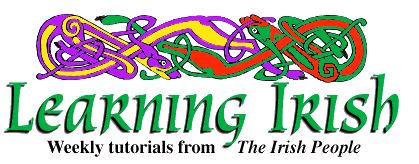
Irish Lesson 37
|
PRONUNCIATION The Irish words for "on me, on you", etc., are examples of several of the pronunciation principles that you have learned. "Orm", on me, is (OH-ruhm), with a short (oh) sound that may resemble English (uh). The "r" is broad, with a brief trilled or rolled effect. "Ort", on you, is (OH-ruht), with the "t" broad. For "air" (er), on him, the "r" is slender (see Lesson 29), but in "ar" (er), the "r" is broad. For "orainn" (OH-rin) and "oraibh" (OH-riv), the first syllable is like that for "orm". For "orthu", on them, the word ends in a (huh) sound, (OHR-huh), because of the aspirated "t".
PRONUNCIATION REVIEW Read this passage slowly without looking at the Key below it. Then read it a second time, making use of the Key if you are unsure. Do not try to make sense of the words; concentrate on the pronunciation and on grouping the words into phrases. Dá mba léir, tháinig roinnt iascairí aici, ar an abhainn, níos mó ná riamh, agus a thaithíonn an-chuid téipeanna, le linn an fheachtais seo. Beidh sé chomhpháirteach, a chuireann as go mór, b'fhiú dó a chur go gcaithfeadh sé, go bhfuil leagan amach bunúsach, ar íosmhéid cainte, agus chothaigh sé neamhchinnteacht, ina measc. Key: daw* muh LAY*R, HAW*-nig rint EES-kuh-ree a-KI, er un OU-in, nees moh naw* reev, AH-guhs uh hah-HEE-uhn AHN-k*wid TAY*P-uh-nuh, le lin un AK*-tish shuh. be shay* hoh-FAW*R-tyuhk*, uh K*IR-uhn as goh MOHR, byoo doh uh K*UR goh GAH-huhk* shay*, goh vwil LAG-uhn uh-MAHK* bun-OOS-uhk*, er EES-vay*d KEYENT-e, AH-guhs K*OH-hee shay* nyav-HYIN-tyuhk*t, IN-uh mask. Note that the "f" in "caithfeadh" gets only an (h) sound. This occurs in the future tense and in conditional forms of the verbs, which you will soon study. By now, you should be losing your fear of long, new words, and you should be able to give unfamiliar words a nearly correct pronunciation. We will continue with this type of pronunciation exercise for several more lessons.
GRAMMAR You know how to say "he is writing", "he wrote", and "he was writing" in Irish. "He is writing" means that at this time someone is actually writing. When we say "he writes", however, we mean that a person writes now and then, more or less frequently, but that he may not be writing at this instant. Irish makes the same distinction, and we say that "he writes" is in the present habitual tense. It forms the imperative, scríobh, and looks like this: scríobhaim (SHKREEV-im), I write scríobhann tú (SHKREEV-uhn too), you write scríobhann sé, he writes scríobhann sí, she writes scríobhaimid (SHKREEV-uh-mid), we write scríobhann shibh (shiv), you (pl) write scríobhann siad (SHEE-uhd), they write For the negative, put a "ní" (nee) before these forms. "Ní" aspirates where possible. The "s" in "scríobh" cannot be aspirated: Ní scríobhaim. With "díol" (DEE-uhl), sell, however: Ní dhíolaim (nee YEE-lim), I don't sell. For the questions, put "an" (un) or "nach" (nahk*) before the basic forms. Both eclipse wherever possible: An scríobhann tú go minic? Do you write often? Nach ndíolann sé feoil? (nahk* NEE-luhn shay* FYOH-il) Doesn't he sell meat?
VOCABULARY carr (kahr), an auto aon charr amháin (ay*n k*ahr uh-WOYN), only one auto dhá charr (gaw* k*ahr), two autos trí (tree) charr, three autos ceithre (KER-e) charr, four autos cúig (KOO-ig) charr, five autos sé (shay) charr, six autos tóg, ag tógail (tohg, uh TOHG-aw*-il), take, lift scar, ag scaradh (skahr, uh SKAHR-uh), separate bearr, ag bearradh (byahr, uh BYAHR-uh), shave ceap, ag ceapadh (kyap, uh KYAP-uh), think
EXERCISES 1. Go through a progressive drill in the present habitual for each of these combinations: bris; cupáin agus plátaí buail; an teach leis an gcarr ceap: é sin cuir; na rudaí sa seomra eile For example: An mbrisim cupáin agaus plátai? Ní bhrisim (VRISH-im) cupáin agus plátaí. Briseann tú cupáin agus plátaí. An mbriseann tú cupáin agus plátaí? Etc. 2. In answer to the question: "Cén t-am é? (kay*n TOUM ay*) What time is it? go through this drill: Cén t-am é? Tá sé nóiméad (NOH-may*d) roimh (rev) a haon a chlog. What time is it? It is one minute before one o'clock. Cén t-am é? Tá sé nóiméad tar éis (tuhr AY*SH) a dó a chlog. WHat time is it? It is one minute after two o'clock. Continue with: two minutes before three o'clock; two minutes after four o'clock; three minutes before five o'clock; three minutes after six o'clock, and so on, to six minutes after twelve o'clock. 3. Read these verb forms, deciding quickly whether they give a command, are in the present habitual tense, or are in the past tense: Glan mé. Magaimid. Thuigeamar. Dhíol sé. Closisim. D'ól mé. Siúil! Chrochaigh mé. Deisigh é! Buaileann siad. Key: Clean me. We mock. We understood. He sold. I hear. I drank. Walk! I hung. Repair it! They strike. 4. Review counting from one to twelve.
(c) 1997 The Irish People. May be reprinted with credit. |